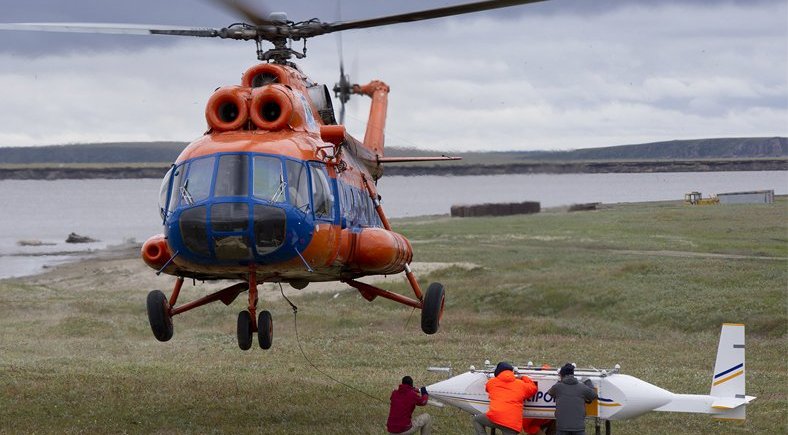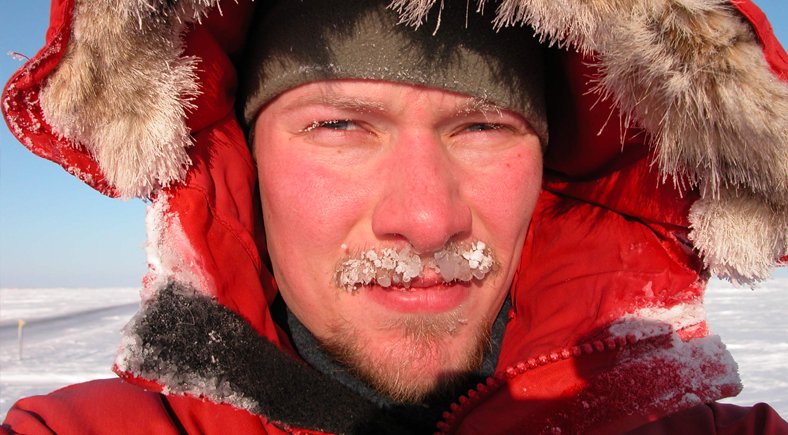Torsten Sachs has already been on expeditions in many inhospitable areas, but there has never been such a complex preparation, even for him: Shooting training to be prepared for possible polar bear attacks, survival training in the water, helicopter rescue practice – the preparation program alone would have been an adventure for many. The group leader from GFZ Section Remote Sensing and Geoinformatics has a place on the 'Polarstern', the research icebreaker that is currently frozen in the Arctic ice and drifting towards the North Pole. The project 'MOSAiC' is the largest Arctic expedition in history. Around 600 researchers and support staff from twenty nations are on board throughout the expedition. Staff is exchanged every two or three months – by icebreakers approaching Polarstern, and in spring by aircraft and a specially prepared landing strip on the ice.
Four of these ships support the Polarstern of the Alfred Wegener Institute for Polar and Marine Research (AWI) which leads the expedition. In addition, there are helicopters. They not only transport personnel, but also serve to explore the icy environment. Together with the Technical University of Braunschweig, Torsten Sachs has had a helicopter-borne probe brought on board, the 'Helipod', with which he sets off in search of the greenhouse gas methane. His project is called Alexia (Analysis Linking Arctic Methane, Carbon Release, Heat Fluxes and Sea Ice from Local to Sub-Regional Scales by Airborne Measurements) and is funded by the German Research Foundation DFG.
Many of the processes in the far north are not yet well understood. "We do not know where the methane comes from – was it dissolved in water and then outgassed or is it formed by biological processes in and under the ice?" These are questions that concern Torsten Sachs. To find out, he and his colleagues will take samples of the air, ice and water and examine them with the help of isotope analyses. "My colleague Ellen Damm from the AWI is the leading expert here," says Sachs.
But the helicopter probe can measure more than greenhouse gases. It will also measure heat flows and tiny particles in the air that can become clouds. The aim of the expedition is to gain a better understanding of the climate and environmental changes in the Arctic Ocean. What is already known is that the region is warming much faster than the models initially predicted.
A few days ago, Torsten Sachs set off on a journey into the night. This far north – at present the Polarstern is drifting at around 87 degrees northern latitude – the sun will not rise for six months. Temperatures around 25 degrees below freezing point are normal. "The cold doesn't bother me," says Sachs, who has already lived in northern Alaska for a year. "But I will have to get used to the dark." A stay of two months is planned. But it's impossible to say for sure. It depends on the ice and weather conditions when the polar explorer can return. "Early April, if all goes according to plan," Sachs says. Apart from the scientific curiosity that drives him, he gives another reason: "There is a chance like this maybe every hundred years." (jz.)









![[Translate to English:] Torsten Sachs in front of a climate station on a field](/fileadmin/_processed_/3/9/csm__TorstenSachs_bearbeitet_GS_4a1365ef84.jpeg)

![[Translate to English:] left image flood at the Ahrtal: image from above, several houses are flooded; left image:: Heidi Kreibich;](/fileadmin/_processed_/4/4/csm_Bild2_9af0130e9f.png)



![[Translate to English:] Start der Vega Rakete](/fileadmin/_processed_/6/4/csm_20231201-kachel_Vega-VV23-launch_ESA-CNES-Arianespace_706716b68c.jpeg)









![[Translate to English:] Poster exhibition at the Brandenburg Hydrogen Day at the GFZ, some participants in the foreground](/fileadmin/_processed_/6/5/csm_Erster_Brandenburgischer_Wasserstofftag_GFZ_402fcec95e.jpeg)
![[Translate to English:] Group picture of the participants](/fileadmin/_processed_/9/4/csm_20231108_CAWa-Workshop-Tashkent_Gruppenbild_99ea779d8a.jpeg)

![[Translate to English:] [Translate to English:] Hörsaal](/fileadmin/_processed_/e/6/csm_H%C3%B6rsal_e21ac645fb.jpeg)


![[Translate to English:] The Delegations in the Historic Library on the Telegrafenberg. In the back there are from left to right, the Dutch Ambassador for Germany, Ronald van Roeden, the Dutch Minister for Education, Culture and Science, Robbert Dijkgraaf and the scientific director of the GFZ, Susanne Buiter.](/fileadmin/_processed_/d/b/csm_Kachel-2_9eba4b4212.jpeg)

